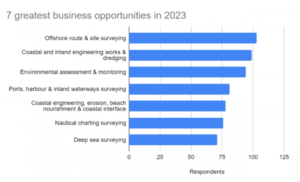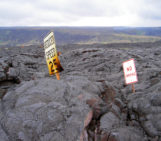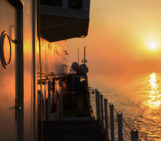
This week on 21st June, governments around the world observed World Hydrography Day to celebrate the role of hydrography in understanding the seas. Though initially thought to be a field limited to the navigation of ships, hydrography is being increasingly recognized for its knowledge contribution to the oceans, seas, coastal areas, lakes and rivers, as well as with predicting their change over time.
This year’s theme is “Hydrography – underpinning the digital twin of the ocean,” highlighting the interconnected relationship between hydrography and the ocean. If you’re curious about hydrography and what it entails, here are five things about the field you may not have known.
#1: Hydrographers measure the “physics” of the seas
Hydrography focuses on the physical features of water bodies, drawing on observations from the past and present, and estimating their behaviour in the future. Hydrographers typically record features such as coastal topography, bathymetry (depth) and oceanographic measurements such as tides and currents. They use multibeam sonar and other instruments to gather millions of data points to generate high-resolution maps of the seafloor. The data collected are used for nautical charts, geospatial applications, and Geographic Information Systems (GIS).
#2: From defence to tourism: Hydrography underpins all
The International Hydrographic Organization explains the multi-dimensional role of hydrography beyond navigation and research: hydrography plays a key role in our understanding of resource exploitation (fishing, minerals), environmental protection and management, maritime boundary delimitation, national marine spatial data infrastructures, recreational boating, maritime defence and security, tsunami flood and inundation modelling, coastal zone management and tourism.
In the past few decades, additional factors have emphasized the need for adequate hydrographic survey coverage, including changing maritime trade patterns, the growing importance of seabed resources, and the U.N. Law of the Sea Convention that inevitably affects areas of national jurisdiction.

Hydrography respondents on the types of survey projects they expect to provide the best business opportunities in 2023. Source: 2022 survey by Hydro International
#3: Hydrography brings with it several economic benefits
According to a 2023 Brochure by the International Hydrographic Organization, there are “considerable economic benefits” of having up-to-date knowledge of the marine environment. Not only can hydrographic information be used by countries to develop infrastructure such as ports, but it can also be used to develop the Blue Economy. Furthermore, information relating to seabed topography or the strength and regularity of currents can be used to develop marine renewable energy projects. Environmental factors such as temperature, salinity and currents can be used by industries like fishing and aquaculture to optimize their activities.
#4: With three centuries of progress, hydrography continues to evolve
In a 2019 interview, Laurent Kerléguer who was appointed Director-General of the French hydrographic office, discussed hydrography’s progress since its beginnings three centuries ago. “Technology has done a lot to improve our methods and efficiency over the past 300 years and since the time of the ‘hydrographic circle’. There have been major breakthroughs such as sonar, global positioning, multibeam echosounders, Lidar… and the innovations are set to continue.” On what the future of hydrography could look like, Laurent said that autonomous underwater vehicles are on their way to becoming a standard asset for hydrography. He added that “we are now only just beginning to envisage what artificial intelligence (AI) will bring to our discipline.”
Another example of recent progress is the launch of the “Empower Women in Hydrography” project that raises awareness of hydrography career opportunities and aims to increase the number of women in leadership positions. Last year (2022), the project was officially endorsed as a UN Ocean Decade Action.
#5: An incomplete field, hydrography calls for more hands on deck
Most hydrographic institutions agree that there is much left to be done to increase the coverage and sharing of hydrographic data. Huge gaps exist in our understanding and exploration of the oceans and other water bodies. Interestingly, technological progress has in some ways led to new hydrography challenges: for instance, the advent of accurate satellite navigation has made poorly positioned historical data a problem for navigators.
A 2022 survey by Hydro International reveals that “in the coming years, the biggest challenge for the hydrographic industry will be to attract and train a new generation of surveyors, followed by adapting to new technologies (autonomy, AI, etc.) and training and competency development.”
In the last few years however, joint international efforts have been trying to address some of these challenges. From 2019 to 2021, many European states participated in the EMODNET programme to produce databases and digital terrain models of European seas. The GIS data has been made freely available to all users from research, industry, governments and the general public, both as a view service and for download.
Looking ahead, the United Nations General Assembly encourages intensified efforts to build capacity for developing countries, to improve hydrographic services and the production of nautical charts, to enable the mobilization of resources, technical capabilities and information for the provision of hydrographic services around the world. The field of hydrography is no doubt a fascinating one, but it could certainly use more investment from every stakeholder involved.



